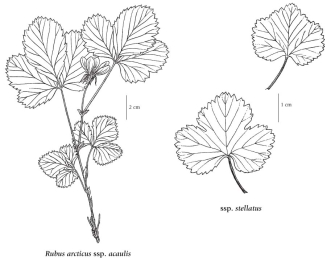Rubus arcticus L.
nagoonberry (arctic blackberry; dwarf nagoonberry)
Rosaceae (Rose family)
Introduction to Vascular Plants
nagoonberry (arctic blackberry; dwarf nagoonberry)
Rosaceae (Rose family)
Introduction to Vascular Plants
SUBTAXA PRESENT IN BC
Species Information
General:
Perennial herb (rarely somewhat woody at the base) from a slender rhizome; annual flowering shoots erect, 5-15 cm tall, several, tufted, leafy, unarmed, finely soft-hairy.
Leaves:
Alternate, deciduous, 2 to 5 per flowering shoot, long-stalked, palmately compound or shallowly lobed, the stalks more or less hairy; leaflets or lobes 3, the leaflets, if present, wedge-egg-shaped, 1-5 cm long, the leaflets or lobes usually rounded at the summit, coarsely single- or double-toothed except near the base, greenish on both surfaces, smooth to hairy above, paler and usually hairy especially on the veins beneath; stipules lanceolate to egg-shaped.
Flowers:
Inflorescence of 1 to 3 stalked flowers atop erect leafy shoots; corollas pink to rose, the petals 5, lance-egg-shaped to spoon-shaped, 8-18 mm long, erect; calyces fine-hairy and sometimes glandular, 5-lobed, the lobes narrowly lanceolate, 5-13 mm long, bent back; ovaries superior; stamens 30 to 40, the filaments flattened.
Fruits:
Drupelets, 20 to 30, smooth, coherent in a red to purplish, globe-shaped cluster, about 1 cm wide, that separates from the dry receptacle (raspberry-like).
Notes:
Two subspecies occur in BC:
1. Leaves compound; calyces lacking glands; frequent throughout BC............... ssp. acaulis (Michx.) Focke
1. Leaves 3-lobed or nearly entire; calyces with yellow glands; rare in NW BC................. ssp. stellatus (Sm.) Boivin
Illustration

If more than one illustration is available for a species (e.g., separate illustrations were provided for two subspecies) then links to the separate images will be provided below. Note that individual subspecies or varietal illustrations are not always available.
Illustration Source: The Illustrated Flora of British Columbia
USDA Species Characteristics
Flower Colour:
Red
Blooming Period:
Summer
Fruit/Seed characteristics:
Colour: Red
Present from Summer to Fall
Source: The USDA
Ecology
Ecological Framework for Rubus arcticus
The table below shows the species-specific information calculated from
original data (BEC database) provided by the BC Ministry of Forests and Range.
(Updated August, 2013)
The table below shows the species-specific information calculated from
original data (BEC database) provided by the BC Ministry of Forests and Range.
(Updated August, 2013)
| Site Information |
Value / Class |
||
|
Avg |
Min |
Max |
|
| Elevation
(metres) |
1104 | 5 | 2300 |
| Slope
Gradient (%) |
4 | 0 | 75 |
|
Aspect (degrees) |
24 | 0 | 360 |
| Soil
Moisture Regime (SMR) [0 - very xeric; 4 - mesic; 8 - hydric] |
5 | 2 | 8 |
| Modal
Nutrient Regime
Class |
C | ||
| #
of field plots species was recorded in: |
818 | ||
| Modal
BEC Zone Class |
SBS | ||
|
All BEC Zones (# of stations/zone) species was recorded in |
BAFA(8), BWBS(139), CWH(1), ESSF(110), ICH(63), IDF(10), MH(1), MS(76), SBPS(60), SBS(170), SWB(114) | ||
|
Source:
Klinkenberg 2013
|
|||
Habitat and Range
Bogs, fens, swamps, wet to moist meadows, thickets and open forests in the montane to alpine zones; frequent throughout BC, mostly in and east of the Coast-Cascade Mountains; circumpolar, N to AK, E to NF and S to MT, CO and MN; Eurasia.Synonyms
Synonyms and Alternate Names:
Cylactis arctica subsp. acaulis (Michx.) W.A. Weber
Rubus acaulis Michx.
Rubus arcticus var. acaulis (Michx.) B. Boivin